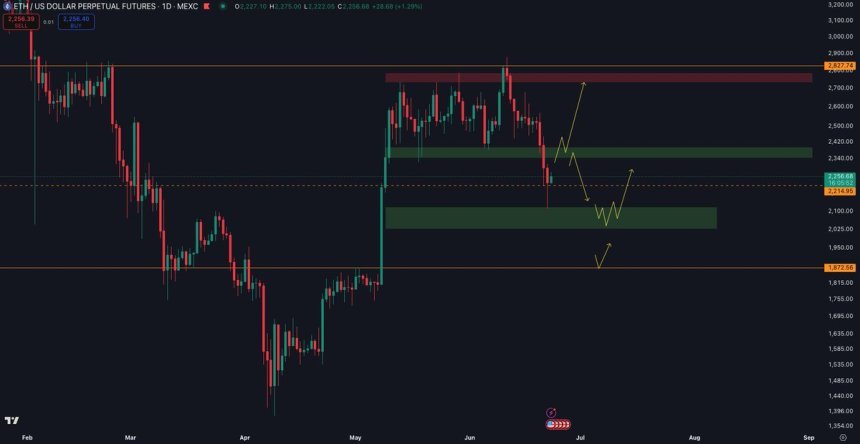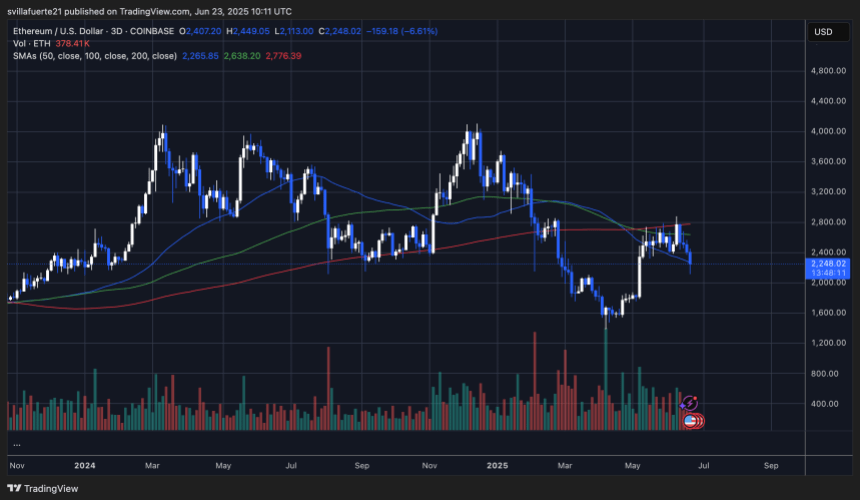Reason to trust
Strict editorial policy that focuses on accuracy, relevance, and impartiality
Created by industry experts and meticulously reviewed
The highest standards in reporting and publishing
Strict editorial policy that focuses on accuracy, relevance, and impartiality
Morbi pretium leo et nisl aliquam mollis. Quisque arcu lorem, ultricies quis pellentesque nec, ullamcorper eu odio.
Ethereum has dropped 17% since Friday, breaking down from the long-standing range that held firm since early May. The sharp sell-off came after news broke of US airstrikes targeting Iranian nuclear facilities, sending shockwaves across global markets and sparking panic selling in risk assets. ETH was no exception, plunging below multiple support zones before finding a temporary floor at $2,100.
Related Reading
This level served as a critical demand area, and Ethereum has since managed to bounce, offering bulls a glimmer of hope in an otherwise uncertain market. However, the breakdown of the previous trading range indicates that momentum has clearly shifted in favor of the bears. According to top analyst Ted Pillows, Ethereum must reclaim the top of the former range to signal that the downside move was a deviation rather than a full breakdown.
As investors digest the growing geopolitical risk and continue to react to macroeconomic pressures such as persistent inflation and hawkish Federal Reserve policy, Ethereum’s path forward remains uncertain. Still, the bounce from $2,100 provides a chance for bulls to reestablish control—if they can push the price back above key resistance levels in the sessions ahead.
Ethereum Holds Support But Bears Still in Control
Recent price action has taken a heavy toll on altcoins, with Ethereum leading the downturn as most assets fall to lower demand levels. Since reaching its early June high, Ethereum has shed over 26% of its value, now trading under intense bearish pressure. Despite the decline, bulls have managed to defend the critical $2,100 support level, providing a temporary floor in an otherwise fragile environment.
Geopolitical instability—particularly the escalating conflict between the US, Israel, and Iran—continues to add volatility and risk aversion to the market. Investors remain cautious, with the broader macroeconomic backdrop dominated by high US Treasury yields, stubborn inflation, and a hawkish Federal Reserve. These factors have put additional weight on the crypto sector, especially on Ethereum, which is widely seen as the main catalyst for a potential altseason that has yet to materialize.
Ted Pillows notes that Ethereum recently tested the $2,100 support and successfully bounced. However, he emphasizes that the price must reclaim the top of its previous range to regain bullish momentum. If ETH fails to break and hold above the $2,350 range low, it risks a deeper move toward the start of the previous impulse leg—or worse.

The coming days will be critical for Ethereum. Reclaiming lost levels would indicate strength and possibly kick off the long-awaited altcoin rotation. But continued rejection could signal more downside ahead, with sentiment already fragile and demand still lacking. Until clarity returns, Ethereum remains in a decisive phase where every candle matters.
Related Reading
ETH Price Analysis: Breakdown Below Key Structure
Ethereum (ETH) has sharply declined, with the price now sitting around $2,248. This move marks a confirmed breakdown from the key range between $2,320 and $2,850, which had been holding since early May. The rejection from the upper resistance zone near $2,850, combined with high-volume selling, indicates clear bearish momentum.

The current candle structure on the 3-day timeframe shows strong downward pressure, especially as ETH failed to hold above the 100-day and 200-day moving averages (currently at $2,638 and $2,776, respectively). These levels now act as dynamic resistance, adding more weight against any short-term bullish reversal attempts.
ETH is also trading well below the 50-day moving average at $2,265, a level that has historically acted as a short-term directional signal. Unless price reclaims and consolidates above that zone, the bearish trend could continue toward the $2,000–$2,100 support cluster—an area that previously sparked buying interest during March’s recovery.
Related Reading
Volume has spiked significantly on this drop, suggesting panic selling rather than a controlled correction. For bulls to regain control, ETH must reclaim the range low at $2,320 quickly. Otherwise, downside pressure could continue to dominate in the near term.
Featured image from Dall-E, chart from TradingView
Read the full article here










